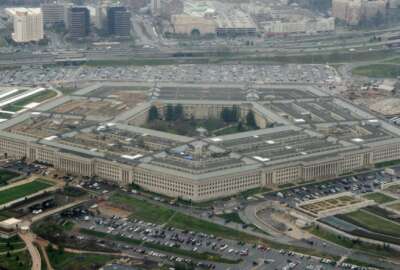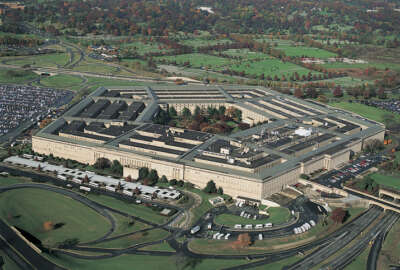
Analyzing new military technology
The director of the Hudson Institute's new Center for Defense Concepts and Technology shares details on the center's mission and focus areas.
Best listening experience is on Chrome, Firefox or Safari. Subscribe to Federal Drive’s daily audio interviews on Apple Podcasts or PodcastOne.
With so much new technology coming into the armed services, and with half the world it seems catching up to the U.S. military, maybe a little transformation might be needed. For how it might look, the Hudson Institute has launched what it calls the new Center for Defense Concepts and Technology. For what it’s looking at and why, the Federal Drive turned to Hudson Institute Senior Fellow Bryan Clark.
Interview transcript:
Tom Temin: Bryan, good to have you back.
Bryan Clark: Thanks for having me on, Tom. It’s great to be back.
Tom Temin: So does the world need another think tank within a think tank looking at defense issues?
Bryan Clark: Well, we think that we do. We saw in the current defense community, there’s not really anybody looking at how new technologies are going to directly impact the operations of future militaries and their strategies. You see a lot of discussion about policy implications of new technology like 5G and artificial intelligence that people in Congress and that people over in DoD, to some degree, are interested in. But we wanted to get into the operational side and focus on how these new technologies might change how militaries operate, what new opportunities might exist, what improved methods of deterrence might be possible, how militaries could become more affordable and more sustainable over the long term. So those are all ideas that we wanted to explore with the advent of new technologies.
Tom Temin: I was thinking about this the other day when Iran was shaking its sabers at U.S. aircraft carriers, and we’ve got 11 of them. And I think four or five or six are never at sea at a given time. And so maybe there’s six, seven, eight that can be out there. And if they can be sunk, then what? We’ve only got eight of them. I mean, it’s not the kind of thing that you’re going to be looking at?
Bryan Clark: Yeah, absolutely. And so, new technologies like autonomous systems, unmanned vehicles, drones, and artificial intelligence are opening up a whole new avenue of power projection and deterrence for militaries. So what we’ve traditionally thought of as a way of deterring, which is to send an aircraft carrier strike group into the Persian Gulf and tell Iran to settle down, they may not be an approach that’s going to be viable for very much longer, because those countries have missiles that can reach out and attack that carrier. The narrative of a carrier on fire in the Persian Gulf is going to be very damaging to U.S. national security and U.,S. reputation even if the carrier is not sunk. Just the fact that that image is out there is going to be damaging enough. So the ability to shift to maybe using a more rebalanced fleet, so a fleet of smaller surface ships with unmanned vehicles, guided by artificial intelligence enables command and control. A lot of the stuff that you see current going on in the commercial world right now can be transitioned into the military. And we might be able to have a more cost-effective way of deterring a country like Iran, using these kinds of platforms than we could with that large, monolithic aircraft carrier that’s been a symbol of American power for so long. They saw their role, but maybe that’s not the right role for them.
Tom Temin: And what will the research agenda be and how will you come up with it at the new center?
Bryan Clark: So we formulated the research agenda. We have a board of advisors, which include people who are working in this space, basically between technology and defense operations. So, folks like Christian Brose, who recently was the Senate Armed Services Committee staff director and now chief of strategy at Anduril, which is a technology company, and people that have former military experience like John Greenert, who used to be the CNO about five years ago. So, those folks are helping us develop the research agenda. But the agenda we have thus far is looking at autonomous systems and artificial intelligence in a project we’re doing for DARPA called Mosaic Warfare. We’re doing a study looking at the implications of 5G for national security, but more specifically for defense operations. So not just policy implications of 5G, but how could the U.S. military leverage 5G, and how could US military investments improve the U.S. competitive position versus China in 5G. We’re doing a study looking at the future of anti-submarine warfare, which we’ll be publishing next month, that looks at using unmanned systems for that mission instead of manned platforms, as we do today, to achieve more affordability, and we’re doing a fleet architecture study in concert with the Office of Secretary of Defense that we’re we’re going on right now. So we’re looking at a lot of studies that are going to take new technologies and look at their implications for how the U.S. Defense Department operates, how the U.S. military operates and what that means for defense strategy.
Tom Temin: We’re speaking with Brian Clark. He’s senior fellow at the Hudson Institute and director of the new Center for Defense Concepts and Technology. And some of the technologies you listed: autonomy, unmanned, artificial intelligence, 5G–these are all available democratically to almost everyone. And if you compare them to aircraft carriers, or long range heavy bombers or atomic bombs, those are expensive and not available to everybody. But the littlest, terrible place can use artificial intelligence and get their hands on a drone. So it seems like the challenge is really–how do you keep an edge with technology that is cheaply available to anyone that wants to get their hands on it?
Bryan Clark: Yeah, so that’s why we thought it was really important to look at operational concepts and strategy in addition to the new technologies because these technologies are coming whether we like it or not. So, our adversaries are likely to get them and they’re going to employ them in the best way that they know how so we’re not going to be able to maintain the technological advantage that we enjoyed during the Cold War. Instead, we’re going to have to be smarter about what we employ these technologies and come up with ways of operating the military that allow us to take advantage of what few, I guess, advantages we do have; for example, having a force that’s very highly trained and is very expeditionary in its mindset. So you might be able to use unmanned systems, artificial intelligence and our smart operators to create this very complex picture for an adversary that might be difficult for a country like China to decipher and then quickly defeat, and that might be enough to deter them from going after an objective like this Senkaku Islands that Japan controls or Taiwan, even. So there’s a combination of technology with new operational concepts that we think is really powerful, and is essential if we’re going to try to do something in a technological environment where the playing field was pretty level.
Tom Temin: And what about the lethality question because I mean, up until now, in war, you had to kill more of them than they killed of you? And is that still going to be part of the equation, sadly?
Bryan Clark: That’s a terrific question. So yeah, one big thing we’re seeing, one big change we’re seeing in the character of warfare is a shift away from attrition-centric warfare, which is kind of the basic U.S. approach that we’ve had over the last 20 years since the Cold War ended, essentially. We’ve essentially gone after our enemies and tried to destroy as much of them as possible to eventually cause them to either give up or to eliminate the threat to the United States. If you think of Iraq, if you think of the counterterrorism operations that we’ve had, you think of what we did in Libya, those have all been attrition-centric fights. Going into the future, we think we’re moving to a world where it’s much more about maneuver and affecting the adversaries’ decision making, because China and Russia don’t want to have World War III with the United States and a fight to the last soldier. They want to get what they want through guile through cyberwarfare, through political warfare, to get their objectives with the least cost possible. So if we can affect their decision-making and cause them to choose a less dangerous path or to accept the status quo, that’s going to be a win. So we have to change our theory of victory and what we consider to be the the metrics for military success in this world where it’s not about attrition anymore. It’s much more about decision-making and creating dilemmas for an enemy.
Tom Temin: It seems like the elements behind the military that have always been nationally important to any country, which is its economy, its diplomacy. And I would say its intellectual property. For want of a better word, its brainpower. It seems that those will still be important, and maybe even more so now than its lethality and force projection.
Bryan Clark: Yeah, absolutely. If we’re not going to be in a world where it’s all about how quickly and many of the enemy you can kill, it’s going to be much more about who can outsmart the other side and cut off options that would allow the enemy to get an easy win. So you’ll think about Ukraine and Crimea and how Russia was able to take advantage of the international situation to get a quick win with a low cost. Cutting off those kinds of options with the way that we operate our military and the way we use our other defense capabilities, that’s where new technologies might be able to afford us an advantage if we have the right operational concepts. But that’s the kind of world we’re going to be in, not the kind of world where we had Desert Storm, where it was destroying every Iraqi tank until the Iraqi government surrendered, essentially.
Tom Temin: Well, that was kind of fun to watch. But the final question, I guess, would be the Defense Department has been trying mightily to get new players, new technology, new industrial base, if you will, into its sphere. And that’s going to be one of the more difficult accomplishments to get done–shifting the industrial base to these types of outfits that can do these new things.
Bryan Clark: Absolutely. And that’s a focus of our work. In our research agenda, we’re going to be in each of these studies looking at how do we import these technologies that are maybe being primarily developed on the commercial side into the defense space, and the challenges there, if you’re a commercial company making returns of 10 times, 20 times on your technology investments, you’re not going to want to sell to the Defense Department and make a 10% return. That’s the kind of earnings that your venture capital investors are not interested in. So we have to come up with a model where these commercial providers are going to be incentivized to help provide capabilities to the Defense Department, which may mean accepting prices that we would not want to pay normally for a defense capability, but that would be more commensurate with what you might pay for on the commercial side. Think about an iPhone. The return for that is probably 50 to 60% for Apple. The Defense Department doesn’t want to pay those kinds of prices, but that may be the kind of change that is necessary to bring in commercial capabilities. So these new models and new approaches for bringing in outside technologies is something we’re going to be looking at at the center.
Tom Temin: Of course, paying $2,000 say for the military version of an iPhone is a lot better than paying 100 million dollars for some fighter that doesn’t quite work after 20 years.
Bryan Clark: Right. So that’s the question is that it may seem, individually, like these commercial technologies are too expensive to bring into the Defense Department. But when you look at the alternative, it may be better to take that approach if we can harness these new technologies in support of some concepts that will allow us to achieve victory without having to plan for World War III.
Tom Temin: Bryan Clark is senior fellow at the Hudson Institute and director of its new Center for Defense Concepts and Technology. Thanks so much for joining me.
Bryan Clark: Thank you, Tom. It’s great being on.
Copyright © 2025 Federal News Network. All rights reserved. This website is not intended for users located within the European Economic Area.
Tom Temin is host of the Federal Drive and has been providing insight on federal technology and management issues for more than 30 years.
Follow @tteminWFED
Related Stories





